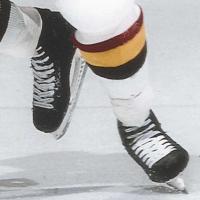Slate
Blackcurrant
Watermelon
Strawberry
Orange
Banana
Apple
Emerald
Chocolate
Marble
Slate
Blackcurrant
Watermelon
Strawberry
Orange
Banana
Apple
Emerald
Chocolate
Marble
-
Content Count
2800 -
Joined
-
Last visited
-
Days Won
92 -
Feedback
0%
Content Type
Profiles
Forums
Downloads
Gallery
Store
MSH News and Articles
Everything posted by flip12
-
Clever. Another Graf detail incorporated by the other brands. CCM had that gap there first, going a few generations back. Now Bauer's got it and throwing in the flex dart for emphasis.
-
Also looks like there’s a Missionesque flex notch between the 2nd and 3rd eyelets at the top.
-
...
-
Let’s see it!
-
Happy to help! I was actually sitting and doing some design sketches when I came across this topic.
-
Just sketched this up. Nothing revolutionary, but it's pretty true to the original.
-
Why don’t they just sew them to the boot?
-
Can you post some pictures of him playing with 5 eyelets laced? That's worth seeing. All-Star games? At what level?
-
Didn’t Evans tape his tendon guard, tongue and upper eyelets in a bundle like Orr?
-
It looks like the TF goalie skates, just with different graphics and a tendon guard. The toe cap and quarter pieces all look very similar to the branding and shell-covering scheme as the TF goal skates.
-

Carbonlite runners from Hyperlite
flip12 replied to Beerleaguebumhockey's topic in Ice Hockey Equipment
Wouldn't more surface melt mean more drag? Comparing to faster ice being ice that's colder, with less of a liquid (pseudo?)layer. -

Carbonlite runners from Hyperlite
flip12 replied to Beerleaguebumhockey's topic in Ice Hockey Equipment
I find it much easier to sprint in my MLX boots that are ~ 70 grams lighter than my classic Grafs, even though I find the flex profile of the Grafs more natural. It sounds dumb it's so simple, but my feet definitely feel significantly lighter in the MLX. -

Carbonlite runners from Hyperlite
flip12 replied to Beerleaguebumhockey's topic in Ice Hockey Equipment
First paragraph, how would that work? Would it require a new holder or steel cross section? Second paragraph, weren’t Ti runners used in the 90’s? What’s the story with those? Another note in general, on the mass reduction compared to other steel options, at least A/B testing is as simple as swapping out steel. You could test everything, blind ideally. One CarbLite blade in one holder and something else in the other. Then opposite sides, one full set then the other. It would be interesting to see how perceptible the difference is, or if the feel is comparable, etc. -

Carbonlite runners from Hyperlite
flip12 replied to Beerleaguebumhockey's topic in Ice Hockey Equipment
Nitpicking here, but one skate blade on the ice most of the time, not all of the time. The fastest skaters incorporate some jump between strides when they can. I think that's one major differentiator in acceleration performance. -
I've struggled with heel lock in my MLX in the past, and when I tried to really kick my heels in on rebakes, it made a huge difference. The best heel lock I got came from three focus points for me: 1. Kicking my heel in really well, as previously mentioned. The heel of SVH boots is so cavernous and the Achilles area so pliable that it just feels nice when you bake it and it's easy to miss the importance of this step to really drive the fit home there. You really want to get a snug connection between the boot and the foot above the calcaneus. Failing to drive your foot far enough back will kill this. 2. Lacing snug, without overdoing it, from the bottom eyelets by the toe box all the way up to but excluding the third eyelet from the top. I didn't lace or wrap the top with plastic wrap but that's because I like a good deal of eversion in my stride and wrapping the firm facing and quarters prevents that rotation. 3. Massaging the outside of the boot above the heel to promote secure fit around the Achilles.
-
I don't jive with modern skates. The best I've found are MLX, which are just as low cut as my 703s but so much stiffer in the facing that it's hard to get the right balance of feel for the boot and range of motion. 703s just work for me. I just got sucked down this rabbit hole of trying to stuff my feet into the smallest boot I could stand in search of "performance fit," but so far, it seems to just stunt my stride to not have a little wiggle room for the foot to expand on landing and push. I'll give my very snug 703s a few more tries and if they're a no go, I think I'll spring for the F60s, even if I'm a little suspicious of the finer details now. The picture shows Clarino, but the description says Airnet. I think I'll get an actual photo instead of the stock one before buying, just to make sure it's not going to be a blob tongue and tendon guard fiasco. That's the perfect way to sum it up. The G35s feel like a good imitation of a Graf skate, but without the actual soul and appreciation of what makes Graf Graf. You had me convinced on your last 11 words. I just have plenty of skates from all of my research and experimentation and would be thrilled to find something that works in my arsenal if I have it already.
-
Looks like CXN mated with a DriveShaft holder.
-
No idea. I do like the look of the holder, not too fussy. That’s all I’ve seen of them, from another topic here where the OP was looking for replacement steel.
-
https://i.imgur.com/00P9vSe.jpeg
-
This is definitely the 703/4 pattern F60. I've seen a few versions with minor variations. The details you mention are fortunately not what it looks like these have. This is the version I'm considering: Classic felt tongue, grey clarino liner, and traditional 703 tendon guard shape rather than the fat star like Komarov had on his F60s. If these avoid the stiffness overload that killed the wrap on the G35Xs, I'd be happy. My G35s had the airnet liner (ok but not as nice as Clarino, and the padding seemed 2nd rate compared to what Graf used before) and fat star tendon guard but came with a decent felt tongue. They'd work ok, but I bought them a little small, thinking I was getting "performance fit," but that didn't work out.
-
Hey. I'm looking at getting a pair of Graf F60s before something with the classic 703 fit is hard to find, custom only, or worse. Can anyone share experiences on how these compare in stiffness and feel to 703s? I had a pair of G35Xs (tech-mesh nylon quarters) that were so stiff in the facing that they didn't wrap nicely like Grafs normally do. If the flex profile of the F60 is similar to the 703, I might not be able to pass it up.
-
I'm interested to see that video. There is a major difference in anchor points between flex testing at the factory and flex in use. The testing setup looks like if you held out your arms in front of you, put the stick on your forearms and had a buddy push down on the shaft beneath your nose until it flexed 1". This would likely leave nasty bruises on all flesh involved, so don't try this at home. The actual impression of flex in use is how hard it feels to flex the stick when you hold it at the top, press it into the ice at the bottom and apply the load force somewhere in between those two points. Those distances change with cutting, plugging, and hand position, which affects the force equation. If you take a cut stick and an uncut stick and they're the same flex rating, they should perform the same in the factory test unless you cut so much off that the force position has to change. There was that interesting variable flex testing done on all the current sticks about 5-6 years ago that showed how much easier or harder it was to flex the same stick in different zones. That's my best guess.
-
Prostockhockey usually has PM9 in stock if you're a lefty. https://www.prostockhockey.com/sticks/?&search_query=sticks&filter=Retail_Curve_Comparison_fq:"PM9%2FP45%2FW01"&rows=20&start=0
-
For Trues it’s helpful to think of a new concept: positive space. It’s well known how well they bake and that they have minimum negative space because of this. But the baking shifts almost any way you want (some portions of the boot are relatively fixed, much more resistant to thermoforming). That means they also move up and out around protrusions of the foot. If I were buying a new pair of Trues I would probably lean toward the one just smaller than what I can squeeze into prebake.


